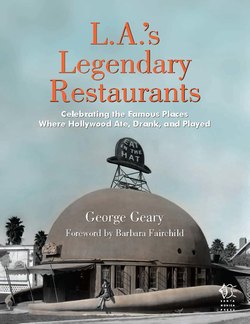Читать книгу L.A.'s Legendary Restaurants - George Geary - Страница 8
ОглавлениеTRENDS IN FOOD, DRINKS, AND RESTAURANTS HAVE CONTINUALLY CHANGED OVER THE DECADES, BUT LOS ANGELES HAS ALWAYS LED THE WAY WHEN IT COMES TO CELEBRITIES, CUTTING EDGE FOOD, AND WILDLY POPULAR DINING SPOTS. L.A.’s Legendary Restaurants brings back special memories, detailing the history and lore associated with these establishments.
Such culinary icons as the hot fudge sundae and the tiki bar and its many tropical drinks, as well as striking architectural wonders like the Brown Derby restaurant (shaped like the hat it was named after), were created here. It was at the Pig ’n Whistle’s soda fountain that Shirley Temple enjoyed dishes of ice cream. The Tam O’Shanter Inn on Los Feliz Boulevard was so favored by the film community that it was referred to as the “other” Disney studio commissary. And Hamburger Hamlet was courageous enough to have one of the first mixed-race staffs in the industry.
Robert Taylor and Barbara Stanwyck at Ciro’s.
In the 1940s, dance halls and music venues sprung up to cater to those with less cash to spend. With the growing prevalence of automobiles, the arrival of carhops made dining that much easier. The 1950s brought a television into every house, and with the popularity of hamburgers and sandwiches, dining began to take less time. In the 1970s, new celebrities appeared in the form of chefs. Ma Maison had Wolfgang Puck, L’Ermitage had Jean Bertranou, and Michael’s had Michael McCarty. These star chefs began building personal empires, which often resulted in locations around the country and their brands in grocery stores.
L.A.’s Legendary Restaurants reveals the architects who created the legendary locations, from the famous Paul Revere Williams to the movie studio craftsmen who plied their trade outside the walls of the film lot. Architectural styles ranged from the refined elegance of Perino’s to the Polynesian theme of Trader Vic’s. In this book, you’ll feel the textures of the restaurant designs and meet the chefs and owners. You’ll rub elbows with the famous stars who dined there and learn what their favorite dishes were and which booths were their favorites. You’ll discover the memorable events that took place there. Perhaps best of all, you’ll savor the flavors of the dishes that were prepared in the kitchens.
Many of the stories in this book have been told again and again over the years. But which ones are a hundred percent true? Was Lana Turner really discovered at the Schwab’s Pharmacy soda fountain counter? Did Elizabeth Taylor actually have Chasen’s chili flown to the Cleopatra set in Rome? Was Hamptons really backed or owned by Paul Newman? I know some of these stories are true because I saw them with my own eyes (I witnessed Mr. Newman working at Hamptons myself; I believe he was a secondary partner). For the others, I carefully researched the reports, and did my best to separate fact from fiction.
My research led me all over the country: from the Hollywood and downtown Los Angeles library branches, all the way to Texas, and even across the country to Rhode Island. Throughout it all, the various former employees and owners of the restaurants were gracious, helpful, and incredibly supportive that a book was being created that would celebrate their legacy.
The patio at the Tam O’Shanter Inn, 1933.
Make these recipes for your family and friends. Enjoy the feast, read the stories, and dine like a star. Bon appétit!
GEORGE GEARY CCP
P.S. Throughout the years, some of the restaurants’ addresses have changed, sometimes because the street names themselves have evolved. In 1963, zip codes came into play, and in 1984, West Hollywood became its own city, changing the addresses of many establishments once again. The addresses included in this book are the most up-to-date for their respective venues.
Additionally, for each restaurant, both the original and current (if the business is still in operation) phone numbers are included. Starting the 1920s, phone numbers contained both numbers and letters. The letters told you where the venue you were dialing was located. It was not uncommon for a business to have more than one number. In the 1980s, some of the exclusive restaurants had a separate number for their A-list patrons. These numbers are also included in the book. Today, we have phone and online reservation systems to bypass all of this.
